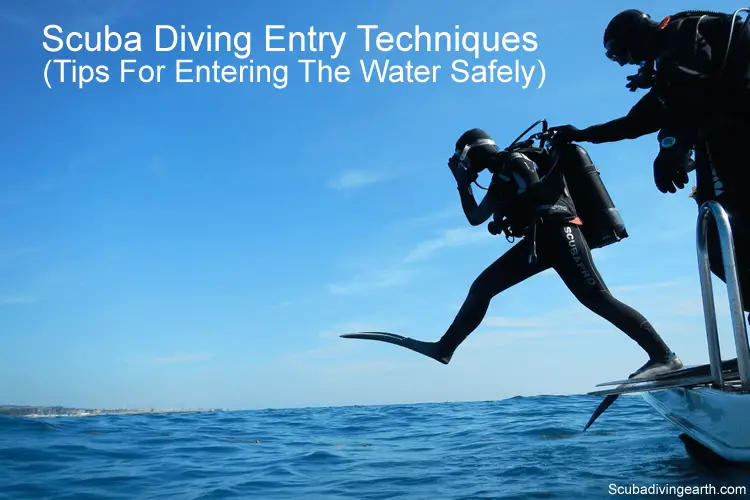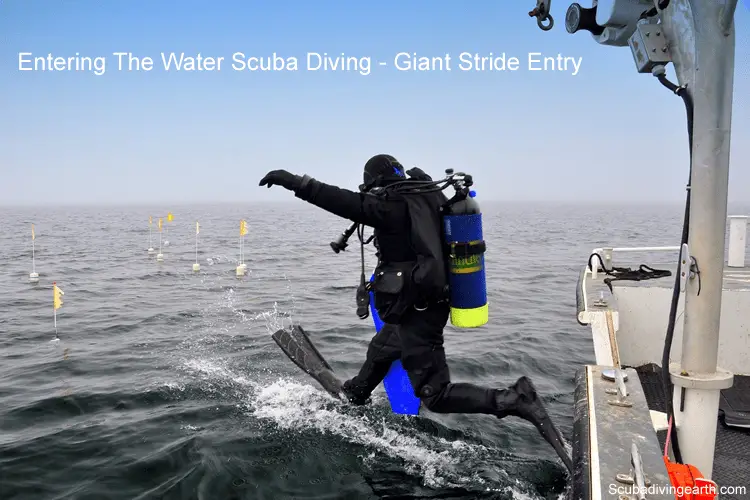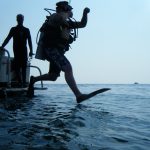
Tips for entering the water safely when scuba diving from a boat or from the shore
Whether you’re diving from a boat or from the shore, you need to enter the water safely when scuba diving. In this article I look at the most common scuba diving entry techniques to know.
Most common scuba diving entry techniques
The five most common scuba diving entry techniques include:
- Giant stride: The most commonly way of entering the water scuba diving on hard boat for deep water entry.
- Back roll: Best used on smaller dive boats like ribs or zodiacs for deep water entry.
- Forward roll: Best used on larger hard bottomed boats for deep water entry.
- Seated entry: – useful water entry technique for shallow water and for entering the water quietly.
- Wading entry: The wading entry is for shoe diving and is also useful for snorkeling too.
The best way to do more diving is to book yourself on a scuba diving liveaboard. You can check the latest and best deals on liveaboards using the following window:
Let’s take a look at each of these scuba diving entry techniques in turn.

1. Giant stride entry method
The giant stride entry method is probably the easiest and most common of the scuba diving entry techniques. It can be used on hard boats, jumping from coastal rocks, or jumping from a pier or jetty.
The giant stride entry technique step by step guide
To perform a giant stride entry you should follow these 11 steps:
- Get kitted up. At this stage don’t put your regulator in your mouth.
- Know the depth. You don’t want to jump into water that’s too shallow and hit the bottom.
- Step close to the edge. To perform a giant stride entry you need to be close to the edge.
- Put air in your BCD. Put enough air into your buoyancy control device (BCD) for positive buoyancy. This brings you to the surface when you jump in. This allows you to come together with your buddy at the surface before descending on your dive as a buddy pair.
- Put your regulator in your mouth. Breathe from your regulator as a final check your regulator is working and your air is switched on.
- Protect your equipment. Put one hand over your mask and regulator to prevent these from dislodging on entry. Put your other arm around your other equipment (your hoses, gauges and dive torch etc.) to avoid these from hitting you as you enter the water.
- Wait for the all-clear from the skipper. Before entering the water, always wait for the boat skipper to give you the all clear. The all-clear indicates the boat is correct placed and the boat is in neutral.
- Check the water in front of you. Make sure no other scuba divers are on the surface or just under the surface in front of you.
- Put one leg forward. Put whichever leg forward that feels comfortable for you in a long stretch and lunge forward.
- Give the okay signal as you surface. Turn to the boat and give the okay signal to someone on the boat.
- Wait for your buddy or fellow divers. If you’re first into the water you must wait on the surface for your fellow scuba divers before you descend.
More Reading: How do I get a dive buddy? (5 easy ways to find a dive buddy)

Extra tips for a giant stride entry
Here are a few extra tips for using the giant stride entry into the water:
- Hold on if the seas are choppy. If you’re on a dive boat in choppy waters hold on where you can to avoid falling over or into the water before you’re ready.
- Aim to enter the water vertically. You need to lunge forward enough to make sure you’re scuba tank doesn’t hit the edge of the boat or whatever platform you’re jumping from. But not too far forward that you enter the water face-first. The aim is to enter the water vertically (See the video below for how not to enter the water scuba diving).
- Leave putting your regulator in your mouth until the last second. Your regulator should be the last thing you put in your mouth. You don’t want to be using up valuable air from your dive tank on the surface.
Giant stride entry video
The above video clearly demonstrates the giant stride entry into deep water. Follow this technique and you’ll be safe.

2. Back roll entry method
The back roll entry method is the best water entry technique for entering the water from a rib, zodiac or other small boat.
You can use the back roll entry method from a larger hard boat, but usually the sides of the boat are too high from the water. This can make this type of water entry unsafe from a high sided boat.
The back roll entry technique step by step guide
- Get kitted up. At this stage don’t put your regulator in your mouth.
- Sit on the side of the boat. To perform a back roll entry you to need to sit on the edge of the boat facing inwards. Which in the case of a rib or zodiac this will be sitting on the tubes (see video below).
- Put air in your BCD. Put enough air into your buoyancy control device (BCD). This should be enough air to make you buoyant enough to bring you to the surface after you’ve rolled back into the water. This allows you to come together with your buddy before you descend on your dive as a buddy pair.
- Put your regulator in your mouth. Breathe in as a final check that your regulator is working and your air is switched on.
- Protect your equipment. Put one hand over your mask and regulator to prevent them from dislodging on entry. Put your other arm around your hoses, gauges and other equipment to avoid these from hitting you as you enter the water.
- Wait for the all-clear from the skipper. Before entering the water, always wait for the boat skipper to give you the all clear. The all-clear indicates the boat is correct placed and the boat is in neutral.
- Check the water behind you. Make sure there are no other scuba divers on the surface or just under the surface where you’re about roll into the water.
- Roll backwards. The back roll entry technique involves you doing a gentle backwards roll off the side of the boat.
- Give the ok signal as you surface. Turn to the boat and give the okay signal to someone on the boat.
- Wait for your buddy or fellow divers. If you’re in first you need to wait on the surface for your fellow divers before you descend.
Extra tips for the back roll entry technique
Here are a few extra tips for using the back roll entry method into the water:
- Point your chin towards your chest. As you roll backwards, point your chin towards your chest. This avoids you from hitting your first stage regulator.
- Put your hand on the back of your head. Some recommend to put one hand over your mask and regulator and the other on the back of your head. Those that recommend this technique say it prevents you from hitting your head on your first stage regulator. But in all the years I’ve dived, I’ve preferred to put my other arm around my equipment. I’ve never hit my head on my first stage.
- Stay calm as you enter the water. The first time you perform a back roll entry, you may feel a bit disorientated when you enter the water. Don’t worry and don’t panic. If you’ve put enough air in your BCD you will pop back up to the surface.
- Checking the water behind you. It’s always advisable when checking the water behind you to look both sides.
Back roll entry method video
3. Forward roll entry method
The forward roll entry method is really just a fun way to enter the water from a hard boat. I’ve never used this technique myself other than when I’ve been teaching the technique to others. I don’t see the point of the forward roll entry myself, as its’ really only a bit of showing off when used.
The forward roll entry is for experienced scuba divers, rather than beginners. If you’re a beginner scuba diver I suggest you stick with the giant stride entry when you are on a liveaboard or hard boat.
The forward roll entry technique step by step guide
- Get kitted up. At this stage don’t put your regulator in your mouth.
- Know the depth. You don’t want to jump into water that’s too shallow and hit the bottom.
- Step close to the edge. To perform a forward roll entry method to need to be close to the edge.
- Put air in your BCD. Put enough air into your buoyancy control device (BCD) to bring you to the surface after you’ve jumped in. This allows you to come together with your buddy before you descend on your dive as a buddy pair.
- Put your regulator in your mouth. Breathe in as a final check that your regulator is working and your air is switched on.
- Protect your equipment. Put one hand over your mask and regulator to prevent them from dislodging on entry. Put your other arm around your other equipment to avoid these from hitting you as you enter the water.
- Wait for the all-clear from the skipper. Before entering the water, always wait for the boat skipper to give you the all clear. The all-clear indicates the boat is correct placed and the boat is in neutral.
- Check the water in front of you. Make sure there are no other scuba divers on the surface or just under the surface where you’re about to jump.
- Bend forward and tuck your head down to your chin. The forward roll entry method requires a little tuck and jump action over the side of the boat. Bend over and tuck your body into a tight ball and push yourself away from the boat with your legs while staying in a ball.
- Give the ok signal as you surface. Turn to the boat and give the okay signal to someone on the boat.
- Wait for your buddy or fellow divers. If you’re in first you need to wait on the surface for your fellow divers before you descend.
Forward roll entry method video
Zoé demonstrates the scuba forward roll entry. It’s less used than the stride entry, but it is handy if a.) you have your hands full such as carrying camera gear or b.) want to show off to other divers. In the forward roll you hit the water on your back, thus protecting the mask and DV.
4. The seated entry method
The seated entry method can be used in water that’s too shallow for the other deep water entry techniques like the giant stride entry method.
Using the seated entry technique is also useful to enter the water to avoid making a big splash and to avoid making too much noise on entering the water. For example scuba diving with sharks.
Often times sharks want to avoid divers. So in order to avoid making too much noise entering the water and scaring the sharks away, use the seated entry method.
There are other underwater creatures that will be disturbed by scuba divers enter the water using any of the above ‘big-splash-techniques.’ If you are mindful of this, try entering quietly and slowly using the seated entry method instead.
The seated entry technique may also be a good water entry technique to use on a night dive.
When diving at night the water looks black and it’s sometimes difficult to see what’s below. A safer way to enter the water if you’re not too sure what’s under the surface would be the seated entry method.
Seated entry method video
How does a controlled seated entry in the water works?
In the video above the distance to the water is quite a lot. The scuba diver demonstrating the seated entry technique still creates quite a splash.
It is possible to enter the water much more quietly than this, unless of course the distance to the water from the boat prevents this.

5. Wading entry method with or without fins
The wading entry method is use to enter the water from the shore with or without fins. It’s a technique used by scuba divers and snorkelers alike.
If you’re a snorkeler and reading this article, miss out the specifics for scuba diving and focus on the bits that are useful to you.
There are two ways to enter the water from the shore with scuba equipment and fins. These include:
- Backwards wading with your fins on.
- Wading out to deeper water holding your fins and putting your fins on in the deeper water.
Backwards wading with fins
Wading backwards from the beach is the method preferred by many. The reason for walking backwards is so that your fins don’t impede your walking or wading. By walking backwards you can drag your fins through the water, which makes it easier to walk.
You have to be careful not to fall over as you walk backwards. When you get to a depth where you can swim, you can either turn around and drop down into the water and swim. Or alternatively, you can fall backwards into the water and turn around once you’re floating.
Wading into the water from the shore holding your fins
The other method to do a shore dive is to wade in until you’re deep enough to swim. Using this technique is better from the view point of stability. Walking wearing fins isn’t the easiest thing to do, even without wearing heavy scuba equipment.
So wading backwards with fins on your feet with heavy equipment can make it more difficult.
Whereas wading in from the shore without your fins, but with your dive boots is much safer. I recommend to wear dive boots to avoid stepping on sharp objects with bare feet.
Using the wading entry method whilst carrying your fins:
- Wade out until you’re in deep enough water to float (a swimming depth).
- Put air into your BCD so you float.
- Lay backwards into the water with your mask on and put your fins on underwater using your mask to see what you are doing.
How not to enter the water scuba diving
I thought this video would be amusing reminder of how not to enter the water scuba diving.
Scuba Divers attempting the James Bond Roll entry and failing miserably!
I hope you enjoyed this article about scuba diving entry techniques
I’d love to hear from you. Tell us about your adventures of scuba diving or skydiving, in the comments below. Please also share your photos. Either from your underwater cameras or videos from your waterproof Gopro’s!
If this article hasn’t answered all of your questions. If you have more questions either about snorkeling or scuba diving (or specifically about scuba diving entry techniques), please comment below with your questions. Please don’t ask too many skydiving questions though!
There will also be many more articles about scuba diving (and snorkeling) for you to read and learn about these fabulous sports.
Have fun and be safe!





